Pangolins: World’s Most Trafficked Mammal
Pangolins are one of the most extraordinary creatures on Earth, often recognized by their scales, which are unlike anything else found on mammals. These small, insect-eating animals are native to Asia and Africa and are easily identified by their overlapping armor-like scales, made of keratin the same material found in human nails and hair.
This natural armor protects pangolins from predators, making them unique in the animal kingdom. Though they may look like reptiles, pangolins are mammals with warm blood, live births, and the ability to nurse their young.
Pangolins are fascinating for many reasons. Their scales are their most distinctive feature, offering them natural protection by allowing them to curl up into a ball when threatened. They’re also known for their specialized diet, primarily consisting of ants and termites, which they catch with their long, sticky tongues.
However, these very traits that make them so unique have also placed them in danger. Pangolins are the world’s most trafficked mammals, with millions poached every year for their scales, which are used in traditional medicine, and for their meat, considered a delicacy in some countries. All eight species of pangolins are listed as vulnerable or endangered, and conservationists around the world are working to protect these remarkable animals from extinction.
Scientific Classification of Pangolins
Pangolins belong to the order Pholidota and the family Manidae. This order includes only one family and one genus, Manis, which encompasses all eight pangolin species. Here’s a quick look at their classification:
| Classification Level | Details |
|---|---|
| Kingdom | Animalia |
| Phylum | Chordata |
| Class | Mammalia |
| Order | Pholidota |
| Family | Manidae |
| Genus | Manis |
| Species | Eight species across Asia and Africa |
The classification highlights how unique pangolins are in the animal kingdom they have no close relatives and belong to their own order. This also means that any extinction would result in an entire lineage of mammals disappearing, making conservation efforts even more important.
Species of Pangolins
There are eight recognized species of pangolins, split between Africa and Asia. Each species has unique adaptations to suit its habitat, which vary from tropical forests to grasslands. Here’s a brief overview of each type:
African Species
Ground Pangolin (Manis temminckii)
Found mainly in southern and eastern Africa, the Ground Pangolin is highly adapted for a terrestrial lifestyle, often dwelling in savannas and woodlands.Tree Pangolin (Manis tricuspis)
Known for its climbing abilities, the Tree Pangolin is found in the forests of West and Central Africa. Its prehensile tail helps it navigate trees.Giant Pangolin (Manis gigantea)
This is the largest pangolin species and is primarily found in the rainforests of Central Africa. The Giant Pangolin can weigh up to 30 kg and is often found near water sources.Long-tailed Pangolin (Manis tetradactyla)
Distinguished by its exceptionally long tail, this species lives in the tropical forests of West Africa and has adapted to an arboreal lifestyle, meaning it spends most of its life in trees.
Asian Species
Indian Pangolin (Manis crassicaudata)
Native to the Indian subcontinent, this pangolin lives in various habitats, from grasslands to dense forests, and is often found near human settlements.Chinese Pangolin (Manis pentadactyla)
Found primarily in China and Nepal, the Chinese Pangolin digs deep burrows and has adapted to survive in colder climates.Sunda Pangolin (Manis javanica)
Native to Southeast Asia, this species prefers tropical forests and wetlands and is one of the most heavily trafficked pangolin species.Philippine Pangolin (Manis culionensis)
Endemic to the Palawan island in the Philippines, this pangolin has a unique scale pattern and is adapted to both terrestrial and arboreal habitats.
Each species faces unique threats, often tied to the illegal wildlife trade and habitat loss, and each has evolved traits that make them distinct in appearance and behavior.
Physical Characteristics and Unique Adaptations
Pangolins are relatively small mammals, with lengths ranging from 12 to 39 inches and weights between 2.5 and 30 kg, depending on the species. Here’s a quick overview of their physical traits:
| Trait | Description |
|---|---|
| Size | 12 to 39 inches in length; 2.5 to 30 kg in weight |
| Scales | Made of keratin, cover most of the body, offering armor-like protection |
| Claws | Strong and curved, used for digging into ant and termite nests |
| Tail | Long and often prehensile, aiding in balance and climbing |
| Color | Varies from brown to yellow-brown |
The scales, which make pangolins so unique, are their primary defense. When threatened, a pangolin curls into a ball, protecting its vulnerable underside with its hard scales. These scales grow throughout their life and are made from keratin, just like human fingernails. This effective armor shields them from most natural predators, although it sadly makes them a target for poaching.
Pangolins have strong, curved claws on their front limbs, allowing them to dig into hard soil and termite mounds. Their long, sticky tongues can reach up to 16 inches, enabling them to probe deep into insect colonies. Without teeth, they rely on small stones they swallow to grind up their food in the stomach, a unique adaptation called gastric milling. The tail of arboreal (tree-dwelling) species is prehensile, allowing them to grip branches and move through trees with ease, while terrestrial pangolins have robust limbs adapted for ground movement.
These physical adaptations make pangolins specialized for their diet and lifestyle, but they also make them vulnerable. Their slow, methodical movements mean they are often easy targets for hunters, and their reliance on specific habitats leaves them highly susceptible to environmental changes. The scales that protect them from predators are the very reason humans hunt them, turning these fascinating creatures into some of the world’s most endangered animals.
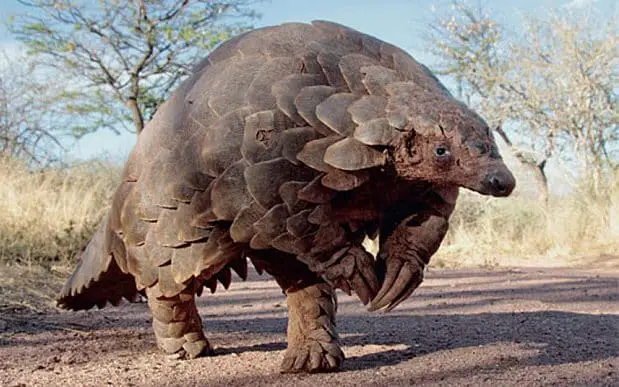
Size
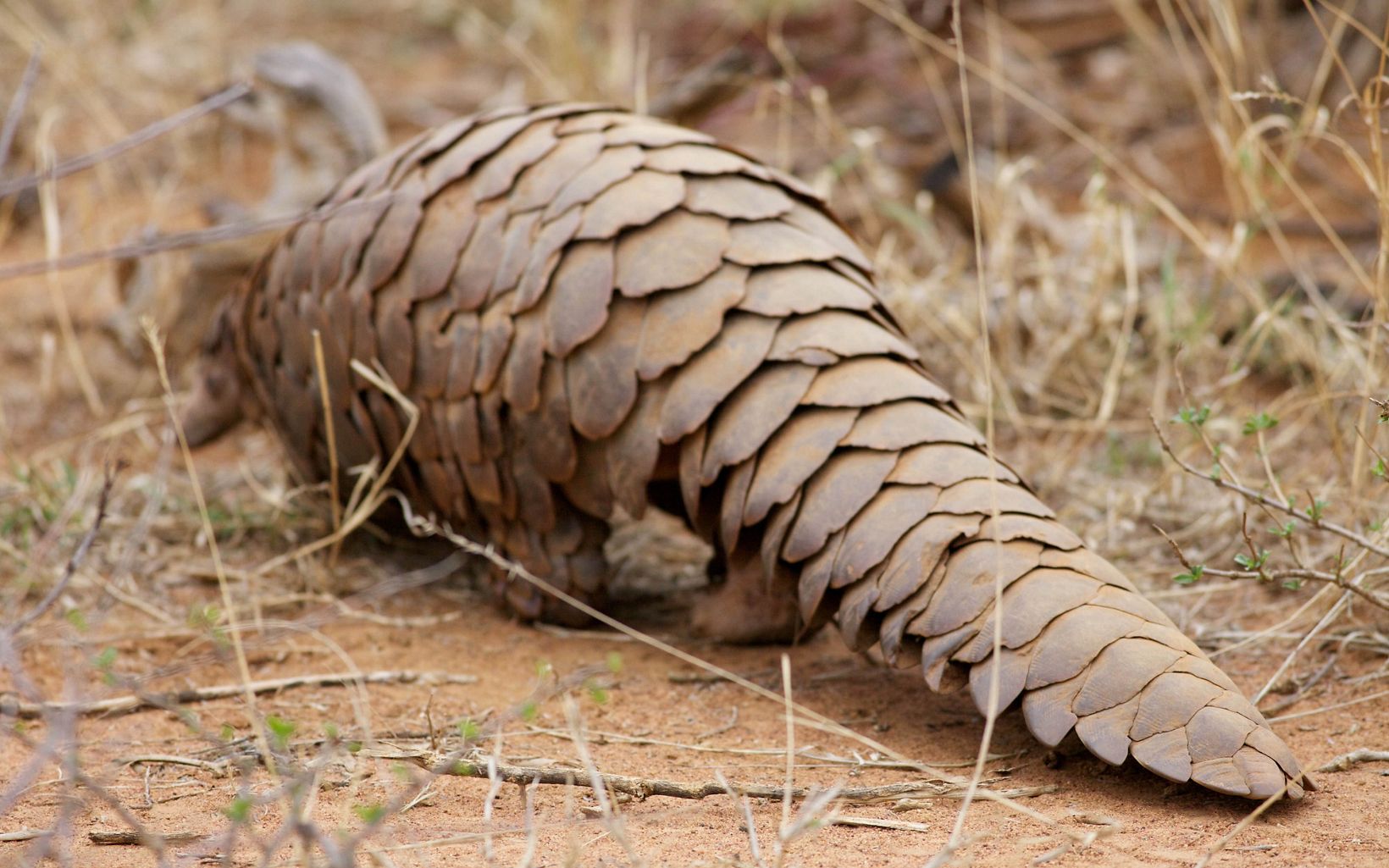
Scales
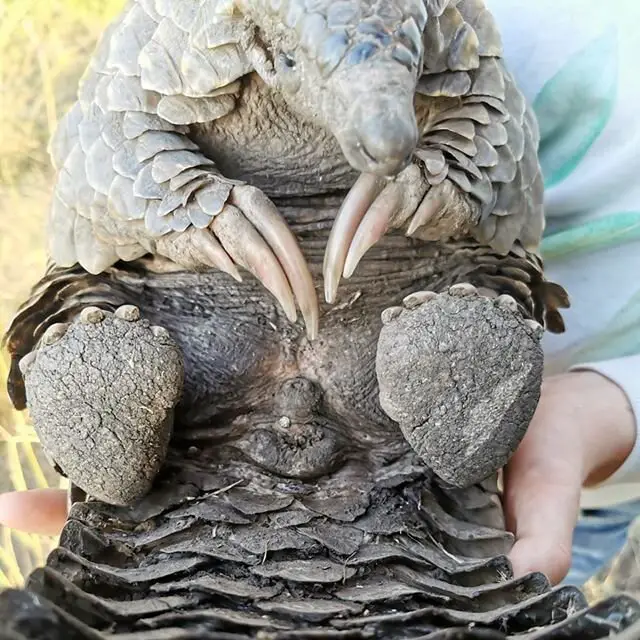
Claws
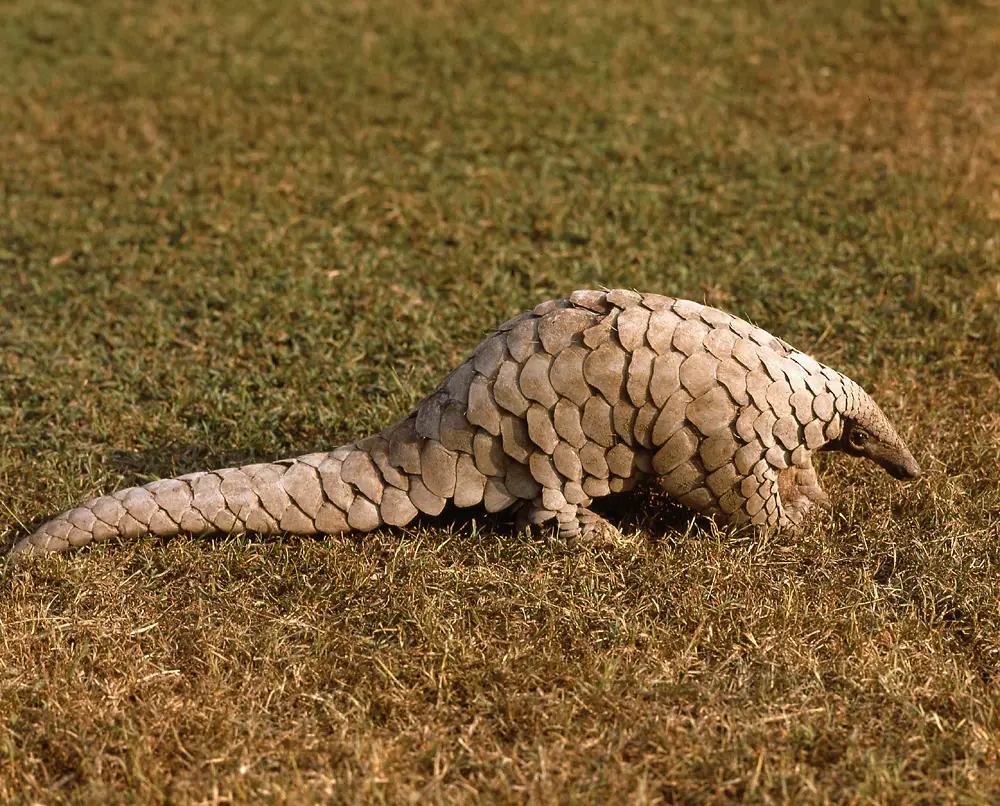
Tail
Behavioral Adaptations
Pangolins are fascinatingly adapted to survive in the wild through several unique behaviors. They are mostly nocturnal, coming out at night to search for food when temperatures are cooler and predators are less active. This night-based lifestyle also allows them to conserve energy in warmer climates. Pangolins are solitary by nature, preferring to live alone rather than in groups. They maintain large territories and usually come together only to mate.
Because their vision is poor, pangolins rely on a strong sense of smell to navigate, locate food, and detect other pangolins in the area. Their heightened olfactory sense compensates for their limited sight, helping them track down ant and termite nests, which are their primary food sources. When pangolins feel threatened, they have a unique defense mechanism—they curl into a tight, nearly impenetrable ball, with their hard, overlapping scales forming a natural shield around their soft underside.
This behavior protects them from most natural predators, as their scales are tough enough to deter large animals like lions or leopards. Some pangolin species have another line of defense: scent glands near the base of the tail. When disturbed, they release a strong-smelling substance to dissuade predators. This scent release is similar to a skunk’s defense mechanism, although pangolins do not spray the scent directly.
Habitat and Geographic Range
Pangolins are native to Africa and Asia, spread across diverse ecosystems in these regions. They inhabit a variety of landscapes, from dense tropical forests to open grasslands and savannas.
African pangolins are generally found in southern and central regions, with species like the Giant Pangolin favoring moist rainforests and others, such as the Ground Pangolin, inhabiting more open woodlands and grasslands. Asian pangolins are located across Southeast Asia, India, and parts of China, often in forested areas with access to loose soil, ideal for burrowing and digging.
Each pangolin species has adapted to survive in its specific environment. For example, the Tree Pangolin and Long-tailed Pangolin, both native to Africa, have strong climbing abilities and long prehensile tails that help them navigate trees.
This adaptation allows them to thrive in tropical forests where they can forage for insects among tree branches. On the other hand, species like the Indian and Ground Pangolin are better adapted to life on the ground, using their powerful forelimbs to dig burrows in savannas and grasslands. Pangolins require access to water and soil that supports insect populations, as their diet consists almost entirely of ants and termites.
Diet and Feeding Habits
Pangolins are specialized insectivores, feeding mainly on ants, termites, and larvae. They rely heavily on their sense of smell to locate insect nests and colonies. Once they’ve found a food source, pangolins use their long, sticky tongues, which can extend up to 16 inches, to extract ants and termites from tunnels and mounds. This unique feeding adaptation allows them to consume thousands of insects quickly and efficiently. Their tongues are attached near the pelvis and are capable of retracting deep into the chest cavity, a feature that allows them to store and use it without obstruction.
Unlike most mammals, pangolins have no teeth. To compensate, they swallow small stones and other abrasive materials that help grind the insects in their muscular stomach, a process known as gastric milling. This adaptation is vital for their survival, as it enables them to digest the tough exoskeletons of ants and termites. As they feed, pangolins help control insect populations in their environment, particularly those of ants and termites, which can cause damage to crops and plant life if left unchecked. By keeping these populations in balance, pangolins play an essential ecological role in supporting soil health and maintaining the natural ecosystem.
Reproduction and Lifecycle
Pangolins have a relatively slow reproductive rate, which is one reason they are so vulnerable to population decline. They typically breed once a year, and the gestation period varies between species, lasting from 70 to 140 days. Female pangolins usually give birth to a single offspring, though twins are occasionally born. Newborn pangolins are tiny, weighing just a few ounces, and are covered in soft scales that harden within a few days. The mother is solely responsible for caring for the young and will carry her offspring on her back or tail to keep it safe from predators.
For the first few months of life, the young pangolin is entirely dependent on its mother. During this period, the mother teaches essential survival skills, such as finding food and detecting predators. The offspring gradually become more independent, but they usually stay with the mother until they are around five months old, when they are capable of fending for themselves. Pangolins’ slow reproduction rate and the extended period needed for young pangolins to reach maturity make them particularly vulnerable to population pressures from poaching and habitat loss.
Pangolins: Ecosystem Contributors
Pangolins play an important role in ecosystems, mainly by controlling insect populations. As natural pest controllers, they consume millions of ants and termites every year. This diet keeps insect numbers in check, helping prevent overpopulation that could damage crops and forests. By digging into termite mounds and ant hills, pangolins also aerate the soil, which aids in nutrient cycling. Their abandoned burrows provide shelter for smaller animals, supporting biodiversity and maintaining a balanced ecosystem.
Diseases and Health Issues
Pangolins can carry zoonotic diseases—diseases that spread between animals and humans—due to their frequent exposure to humans through illegal trade. While they haven’t been confirmed as carriers of COVID-19, their trafficking raises health concerns about disease spread. In captivity, pangolins often struggle with health issues related to their diet and environment, since their natural diet of ants and termites is hard to replicate. Researchers are exploring ways to improve their care in captivity, focusing on diet and stress reduction.
Natural Predators and Defense Mechanisms
In the wild, pangolins face predation from animals like leopards, lions, hyenas, and tigers. However, they have strong defenses. When threatened, pangolins curl into a tight ball, with their hard scales creating a protective shield that deters most predators. Some species also release a foul-smelling odor from glands near the base of their tail to discourage attackers. These defenses work well against natural predators, but sadly, they provide little protection against human poachers.
Conservation Status and Threats
All eight pangolin species are listed on the IUCN Red List as vulnerable or critically endangered due to illegal poaching and habitat loss. They are the most trafficked mammals globally, primarily for their scales, which are mistakenly believed to have medicinal properties, and for their meat, which is considered a delicacy. Deforestation and urban expansion further threaten their habitats, making survival even harder. Below is a summary of major threats:
| Threat | Details |
|---|---|
| Illegal trafficking | High demand for scales in traditional medicine; pangolin meat is considered a luxury. |
| Habitat loss | Deforestation and agriculture reduce their natural habitat, increasing exposure to poaching. |
| Human encroachment | Humans entering pangolin habitats lead to increased risk of hunting and capture. |
Conservation Efforts and Legal Protections
Organizations like the World Wildlife Fund (WWF) and the IUCN are leading efforts to protect pangolins. These groups work to combat illegal trafficking, enforce protective laws, and raise public awareness. Pangolins are protected under CITES Appendix I, which bans international trade in pangolins and their parts. Despite legal measures, enforcement remains a challenge. Increasing public awareness about pangolin trafficking and educating communities about pangolins’ role in ecosystems are essential to preserving these unique animals.
Economic Importance of Pangolins
Pangolins offer indirect economic benefits through their role in pest control. By eating termites and ants, they help protect crops and forests from insect damage, reducing the need for pesticides. However, the illegal trade in pangolins generates millions on the black market, driven by the demand for their scales and meat. Conservationists argue that pangolins provide greater long-term economic benefits alive due to their role in agriculture and ecosystem health.
Interesting Facts About Pangolins
- Pangolins are the only mammals covered entirely in scales.
- They can extend their tongues longer than their bodies to reach insects in deep nests.
- Without teeth, pangolins rely on small stones to grind their food in their stomach.
- A single pangolin can consume up to 70 million insects annually.
- Pangolins can emit a foul odor, like a skunk, to ward off predators.
Future of Pangolins
The future of pangolins hinges on public awareness and conservation efforts. Reducing demand for pangolin products is essential to stopping poaching. Ecotourism may offer an opportunity to educate people about pangolins in the wild, providing economic incentives to local communities to protect them. Conservation groups are also working to restore and protect pangolin habitats, giving these animals a better chance to survive. Through strengthened protection laws, community involvement, and international cooperation, there is hope for a stable future where pangolins can thrive without the threat of extinction.
FAQs- Frequently Asked Questions
What’s So Special About Pangolins?
Pangolins are the only mammals covered entirely in scales made of keratin, which protect them by forming a natural armor. They are known for their long, sticky tongues, which they use to eat ants and termites. These unique traits make them unlike any other mammal.
Why Are Pangolins So Hunted?
Pangolins are highly trafficked for their scales, believed in traditional medicine to have healing properties, and for their meat, which is considered a delicacy in some cultures. This demand has led to extensive poaching, putting all eight species at risk.
Are Pangolins Friendly to Humans?
Pangolins are naturally solitary and shy animals. They are not aggressive toward humans and tend to avoid contact. However, due to their solitary nature, they do not typically interact much with humans.
What Is the Pangolin Skin Used For?
Pangolin scales, made from keratin, are used in traditional medicine in parts of Asia and Africa, although there is no scientific evidence supporting their medicinal value. Pangolin skin and scales are also sometimes illegally used for ornamental purposes.
Why Is Pangolin So Expensive?
The high demand in illegal markets for pangolin scales and meat makes pangolins one of the most expensive trafficked animals. Their scarcity, combined with restrictions on trade, has driven up black market prices.
Is Pangolin in Danger?
Yes, all eight species of pangolins are listed as vulnerable or endangered on the IUCN Red List. Illegal hunting and habitat destruction are the main threats to their survival.
Can Pangolins Lay Eggs?
No, pangolins are mammals and give birth to live young, typically one baby at a time.
What Eats Pangolins?
Pangolins have few natural predators due to their tough scales. However, in Africa and Asia, predators like leopards, lions, and tigers may attempt to prey on them, although their defense mechanism makes them difficult to catch.
Can Pangolins Bite?
Pangolins have no teeth, so they do not bite. They rely on their strong claws for digging and their sticky tongues to capture insects.
Are Pangolins Intelligent?
While pangolins are not known for high intelligence, they display specialized adaptations, such as the ability to use their strong sense of smell to locate food and avoid predators.
How Long Do Pangolins Live?
In the wild, pangolins can live up to 15-20 years. Their lifespan in captivity can be shorter due to difficulties in replicating their diet and habitat.
What Are Pangolins Good For?
Pangolins play an essential role in controlling insect populations, particularly ants and termites. This helps maintain healthy soil and protects crops from insect damage.
Do Pangolins Mate for Life?
No, pangolins do not mate for life. They are generally solitary, only coming together to mate.
How Big Is a Pangolin?
Depending on the species, pangolins range from 12 to 39 inches in length and can weigh from 2.5 to 30 kg.
How Long Is a Pangolin Pregnant?
The gestation period for pangolins is between 70 and 140 days, depending on the species.
Is Pangolin a Dinosaur?
No, pangolins are mammals, not dinosaurs. They are not related to reptiles despite their scale-covered appearance.
What Does Pangolin Eat?
Pangolins are insectivores, primarily eating ants and termites, which they capture using their long, sticky tongues.
Why Are Pangolins in Danger?
Pangolins are in danger due to illegal poaching for their scales and meat, along with habitat destruction caused by deforestation and human encroachment.
What Is the Lifespan of a Pangolin?
A pangolin’s lifespan can reach up to 15-20 years in the wild, though they may live shorter lives in captivity due to stress and diet challenges.
Can Pangolins Hurt Humans?
Pangolins are not dangerous to humans. They are solitary, shy animals and use their scales only as a defense against predators.
Can You Touch Pangolin?
Touching pangolins is discouraged, especially as many are endangered. Additionally, handling wild animals can spread zoonotic diseases.
What Is Pangolin Used For?
Pangolin scales are used in traditional medicines, and pangolin meat is consumed as a delicacy in certain countries, though there is no scientifically proven benefit.
What Is the Secret of Pangolin?
The “secret” or uniqueness of pangolins lies in their full-body scales, insect-based diet, and specialized behaviors, making them one of the most distinct mammals.
Can Pangolin Be a Pet?
No, pangolins do not make good pets. They have specific dietary and habitat needs that are challenging to provide outside their natural environment.
Do Baby Pangolins Drink Milk?
Yes, as mammals, baby pangolins nurse on their mother’s milk until they are ready to eat ants and termites.
Do Pangolins Smell?
Pangolins can emit a strong odor from scent glands near the base of their tail as a defense mechanism.
How Many Pangolins Are Left?
Estimating exact numbers is difficult due to their secretive nature, but all species are declining, with some considered critically endangered.
Are There Pangolins in Pakistan?
Yes, the Indian Pangolin (Manis crassicaudata) is native to parts of Pakistan.
What Do Pangolins Do at Night?
As nocturnal animals, pangolins spend their nights searching for ants and termites to eat, often traveling long distances to find food.
What Medicine Is Pangolin Used For?
Pangolin scales are used in traditional medicine in some cultures, though there is no scientific support for their effectiveness.
What Is Pangolin Blood Used For?
In certain cultures, pangolin blood is used in traditional medicine, although this practice has no proven health benefits.
How Do Pangolins Help Humans?
By eating large amounts of ants and termites, pangolins help control insect populations, which benefits agriculture and reduces the need for pesticides.
What Is the Benefit of Pangolin?
The ecological benefit of pangolins lies in their role as natural pest controllers, helping to protect crops and forests from insect overpopulation.
What Is the Life Cycle of a Pangolin?
Pangolins are born after a gestation of 70-140 days, stay with their mothers for a few months, and reach sexual maturity at around two years.
How Many Babies Do Pangolins Give Birth To?
Pangolins typically give birth to one offspring at a time, though twins are occasionally born.
How Do Pangolins Mate?
Pangolins are generally solitary, coming together only for mating. After mating, the pair separates, and the female raises the young alone.
Can Pangolins Go in Water?
Yes, pangolins are capable of swimming, although they spend most of their time on land.
How Fast Do Pangolins Reproduce?
Pangolins have a slow reproduction rate, with females typically giving birth only once per year.
Do Pangolins Have Milk?
Yes, as mammals, female pangolins produce milk to nurse their young.
Do Pangolins Sleep at Night?
No, pangolins are nocturnal and sleep during the day, emerging at night to search for food.
Learn More About Pangolins
On this page, you can explore articles about the unique behaviors and characteristics of pangolins.
These articles answer common questions about pangolins, including what they eat, their nighttime habits, their specialized scales, reproductive cycles, and how they interact within their natural environments.
Scroll down to discover the incredible adaptations of pangolins and learn why these shy, scaled mammals play such a vital role in the ecosystems where they live.
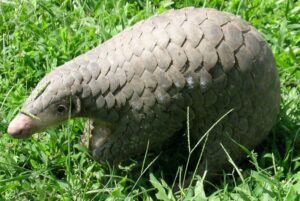
Chinese Pangolin (Manis pentadactyla): Asia’s Rare, Scaled Mammal
The Chinese Pangolin, scientifically known as Manis pentadactyla, is a remarkable and rare species native to Asia. Known for its
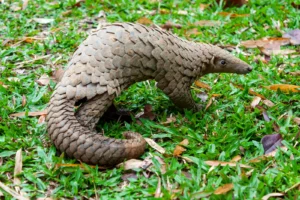
Giant Pangolin (Manis gigantea): A Rare and Remarkable Mammal
The giant pangolin, known scientifically as Manis gigantea, is the largest of all pangolin species. Found in the dense forests
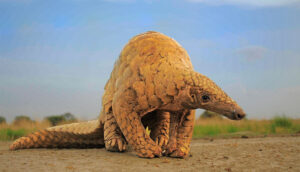
Indian Pangolin (Manis crassicaudata): The Unique Scaled Mammal of India
The Indian pangolin, scientifically known as Manis crassicaudata, is one of the world’s most fascinating mammals. Covered in hard, overlapping
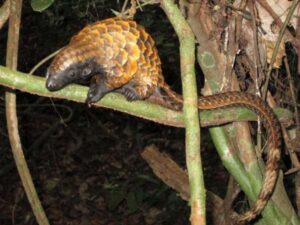
Long-Tailed Pangolin (Manis tetradactyla)
The long-tailed pangolin (Manis tetradactyla), also known as the African black-bellied pangolin, is a unique and remarkable member of the
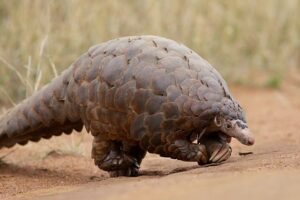
Manis Temminckii – The Ground Pangolin of Africa
The ground pangolin (Manis temminckii), also known as the Cape pangolin, is one of Africa’s rarest and most intriguing mammals.
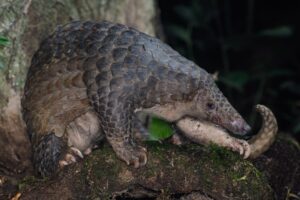
Sunda Pangolin (Manis javanica): The Secretive Scaled Mammal of Southeast Asia
The Sunda pangolin (Manis javanica) is one of the world’s most intriguing and endangered mammals. Found primarily in Southeast Asia,
